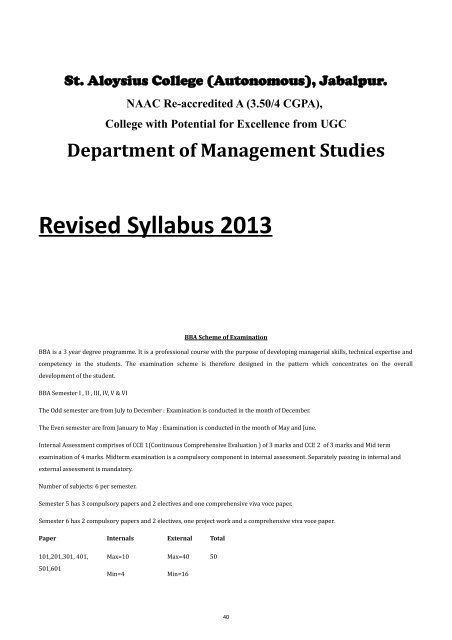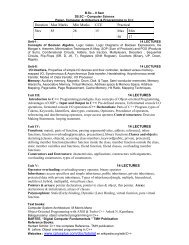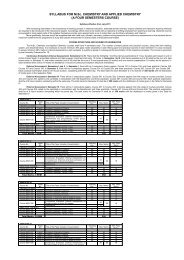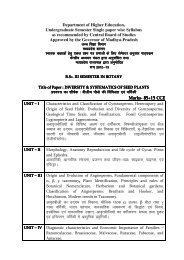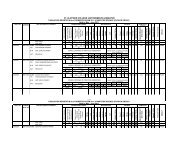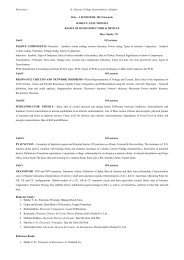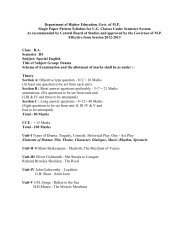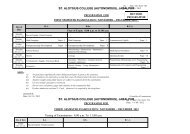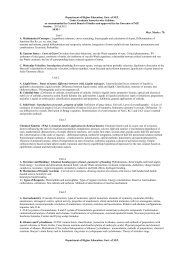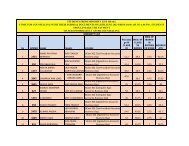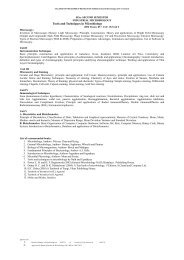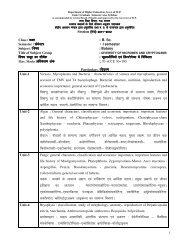bba i to vi semester 2013
bba i to vi semester 2013
bba i to vi semester 2013
- No tags were found...
Create successful ePaper yourself
Turn your PDF publications into a flip-book with our unique Google optimized e-Paper software.
St. Aloysius College (Au<strong>to</strong>nomous), Jabalpur.<br />
NAAC Re-accredited A (3.50/4 CGPA),<br />
College with Potential for Excellence from UGC<br />
Department of Management Studies<br />
Re<strong>vi</strong>sed Syllabus <strong>2013</strong><br />
BBA Scheme of Examination<br />
BBA is a 3 year degree programme. It is a professional course with the purpose of developing managerial skills, technical expertise and<br />
competency in the students. The examination scheme is therefore designed in the pattern which concentrates on the overall<br />
development of the student.<br />
BBA Semester I , II , III, IV, V & VI<br />
The Odd <strong>semester</strong> are from July <strong>to</strong> December : Examination is conducted in the month of December.<br />
The Even <strong>semester</strong> are from January <strong>to</strong> May : Examination is conducted in the month of May and June.<br />
Internal Assessment comprises of CCE 1(Continuous Comprehensive Evaluation ) of 3 marks and CCE 2 of 3 marks and Mid term<br />
examination of 4 marks. Midterm examination is a compulsory component in internal assessment. Separately passing in internal and<br />
external assessment is manda<strong>to</strong>ry.<br />
Number of subjects: 6 per <strong>semester</strong>.<br />
Semester 5 has 3 compulsory papers and 2 electives and one comprehensive <strong>vi</strong>va voce paper.<br />
Semester 6 has 2 compulsory papers and 2 electives, one project work and a comprehensive <strong>vi</strong>va voce paper.<br />
Paper Internals External Total<br />
101,201,301, 401,<br />
Max=10<br />
Max=40<br />
50<br />
501,601<br />
Min=4<br />
Min=16<br />
40
102,202, 302, 402,<br />
Max=10<br />
Max=40<br />
50<br />
502,602<br />
Min=4<br />
Min=16<br />
103,203, 303, 403,503 Max=10<br />
Min=4<br />
Max=40<br />
Min=16<br />
50<br />
104, 204, 304, 404,<br />
Max=10<br />
Max=40<br />
50<br />
Electives 1<br />
Min=4<br />
Min=16<br />
105, 205, 305, 405,<br />
Max=10<br />
Max=40<br />
50<br />
Electives 2<br />
Min=4<br />
Min=16<br />
106, 306, 504,604 Max=50<br />
50<br />
206, 406 Live Project –<br />
Max=30<br />
Min=12<br />
Min=20<br />
Viva-<br />
Max=20<br />
Min=8<br />
50<br />
Maximum Marks: 50 Internal Assessment: 10 & External Assessment: 40<br />
Comprehensive Viva : 50.<br />
Guidelines for the Live Project<br />
<br />
<br />
<br />
The live project would be undertaken as a compulsory component of the BBA curriculum for the second and fourth <strong>semester</strong> from the<br />
year 2011.<br />
Making the live project as a part of the curriculum the live project would hold 30 marks for the students evaluation under the subject<br />
Comprehensive Viva Voce where the remaining 20 marks would be for the Viva of the student on the project concerned.<br />
The subject Comprehensive Viva Voce ( BBA – 206, 406) of 50 marks are distributed as<br />
A) Live Project- Max Marks- 30<br />
Min Marks- 12<br />
B) Comprehensive Viva- Max Marks - 20<br />
Min Marks- 08<br />
<br />
<br />
<br />
<br />
The evaluation of the student under this live project would consist of different parameters.<br />
The students would submit hand written report as a part of their evaluation.<br />
The student must pass separately in both the components of the comprehensive <strong>vi</strong>va voce.<br />
The allotment of project <strong>to</strong> be done by faculty, under the guidance of the Head of the department. The project would be undertaken<br />
under the guidance of faculty member.<br />
Model Question Paper<br />
PAPER #<br />
PAPER NAME:<br />
Time: 3hours<br />
Max. Marks : 40<br />
Min Marks:16<br />
All questions are compulsory. There are three sections, internal choice is given in each section. Each question carries equal marks.<br />
For practical papers: 50% of practical’s questions and 50% theory questions <strong>to</strong> be asked.<br />
1. Section A: Very Short Answer type/Objective Type –(1*5=5)<br />
40
Section B: Short Answer Type. (3*5=15)<br />
2. Unit 1<br />
Question<br />
Or<br />
Question<br />
3. Unit 2<br />
Question<br />
Or<br />
Question<br />
4. Unit 3<br />
Question<br />
Or<br />
Question<br />
5. Unit 4<br />
Question<br />
Or<br />
Question<br />
6. Unit 5<br />
Question<br />
Or<br />
Question<br />
Section C: Long Answer Type (4*5=20)<br />
For Specialization papers of Human Resource, Marketing and Finance: Please include in Long answer Type – Section C a question based<br />
case study as any one Question.<br />
7. Unit 1<br />
Question<br />
Or<br />
Question<br />
8. Unit 2<br />
Question<br />
Or<br />
Question<br />
9. Unit 3<br />
Question<br />
Or<br />
Question<br />
10. Unit 4<br />
Question<br />
Or<br />
Question<br />
11. Unit 5<br />
Question<br />
40
Or<br />
Question<br />
BBA Semester I<br />
BBA Semester II<br />
Paper 101 ENGLISH<br />
Paper 102 MATHEMATICS<br />
Paper 103 PRINCIPLES OF<br />
ACCOUNTING<br />
Paper 104 BUSINESS ORGANISATION<br />
Paper 105 PRINCIPLES OF<br />
ECONOMICS<br />
Paper 106 COMPREHENSIVE VIVA<br />
VOCE<br />
BBA Semester III<br />
Paper 201 BUSINESS COMMUNICATION<br />
Paper 202 COMPUTER APPLICATION<br />
Paper 203 FINANCIAL ACCOUNTING<br />
Paper 204 ELEMENTS OF<br />
MANAGEMENT<br />
Paper 205 PRINCIPLES OF ECONOMICS<br />
Paper 206 COMPREHENSIVE VIVA: LIVE<br />
PROJECT & VIVA<br />
BBA Semester IV<br />
Paper 301<br />
Paper 302<br />
Paper 303<br />
Paper 304<br />
Paper 305<br />
Paper 306<br />
VOCE<br />
MANAGERIAL ECONOMICS<br />
COST ACCOUNTING<br />
PERSONNEL MANAGEMENT<br />
COMPUTER MANAGEMENT<br />
BUSINESS STATISITCS<br />
COMPREHENSIVE VIVA<br />
Paper 401 ORGANIZATIONAL<br />
BEHAVIOR<br />
Paper 402 FINANCIAL MANAGEMENT<br />
Paper 403 MARKETING MANAGEMENT<br />
Paper 404 ECONOMIC LEGISLATION<br />
(BUSINESS & INDUSTRIAL LAW)<br />
Paper 405 BUSINESS ENVIRONMENT<br />
Paper 406 COMPREHENSIVE VIVA:<br />
LIVE PROJECT & VIVA<br />
BBA Semester V<br />
BBA Semester VI<br />
Paper 501 PRODUCTION & MATERIAL<br />
MANAGEMENT<br />
Paper 601 BUSINESS POLICIES AND<br />
STRATEGIC MANAGEMENT<br />
Paper 502 MONEY AND BANKING<br />
PRACTICES<br />
Paper 503 MANAGEMENT<br />
INFORMATION SYSTEM<br />
Paper 504 COMPREHENSIVE VIVA<br />
VOCE<br />
ELECTIVES 1<br />
ELECTIVES 2<br />
Paper 602<br />
Paper 603<br />
Paper 604<br />
ELECTIVES 1<br />
ELECTIVES 2<br />
MARKETING RESEARCH<br />
PROJECT WORK<br />
COMPREHENSIVE VIVA VOCE<br />
ELECTIVES FOR SEMESTER V & VI<br />
MARKETING:<br />
M1<br />
MARKETING STRATEGY<br />
40
M2<br />
M3<br />
M4<br />
M5<br />
CONSUMER BEHAVIOR<br />
ADVERTISING AND SALES PROMOTION<br />
SALES MANAGEMENT<br />
PRODUCT MANAGEMENT<br />
HUMAN RESOURCE:<br />
HR1<br />
HR2<br />
HR3<br />
HR4<br />
HR5<br />
HUMAN RESOURCE DEVELOPMENT<br />
HUMAN RESOURCE MANAGEMENT<br />
SOCIAL PSYCOLOGY<br />
ORGANIZATIONAL DEVELOPMENT<br />
MANAGEMENT OF CHANGE<br />
FINANCE:<br />
F1<br />
F2<br />
F3<br />
F4<br />
F5<br />
PROJECT MANAGEMENT<br />
FINANCIAL CONTROL SYSTEM<br />
MANAGEMENT OF WORKING CAPITAL<br />
SECURITY ANALYSIS AND PORTFOLIO MANAGEMENT<br />
FINANCIAL SERVICES<br />
**********************<br />
BBA SEMESTER I<br />
40
BBA –-SEMESTER I<br />
English<br />
BBA-101<br />
Maximum Marks: 40<br />
Pass Marks: 16<br />
Duration: 3 hours<br />
Unit -I<br />
Countable and uncountable : use of “a, an, the ,some, any, one, once, few, a few, little, a little, much ,many ,plenty of ,a lot of , a great deal of etc.”<br />
Auxiliaries : making negatives and questions of auxiliary verbs short answers using auxiliary verb ; addition <strong>to</strong> remarks question tags ; causative use<br />
of have ; use of ‘must ‘ and ‘must not’ – ‘must and needn’t <strong>to</strong>’ , express commands obligations prohibition (negative commands), absence of obligation<br />
or necessity. 15 lectures<br />
Unit II<br />
Tenses and sequence of tenses; transformation of sentences –active <strong>to</strong> passive voice; direct <strong>to</strong> indirect narration, combination of sentences.<br />
15 lectures<br />
Unit III<br />
Subject verb agreement, preposition, and conjunctions. Precis Writing: Skills of précis writings ,guidelines for effective precis writing- Preparation<br />
of summary of office notes; summary of matters appearing in economic and commercial dailies and journals for use in committee meetings in the<br />
office; summary of decisions taken in meetings and conferences.<br />
15 lectures<br />
Unit IV<br />
Derivations of words using ‘Prefixes’ and ‘Suffixes’. Synonyms and an<strong>to</strong>nyms, use of ‘Idioms and ‘Proverbs’. Common errors in the use of grammatical<br />
items included in all above <strong>to</strong>pics. 15 lectures<br />
Unit V<br />
Composing paragraphs of about 100-150 words based on <strong>to</strong>pics of day <strong>to</strong> day happenings and general awareness. Essay Writing: Basic skills of<br />
effective paragraph writing and essay writing, Essays on matters of current interest on trade, commerce, industry and profession.<br />
15 lectures<br />
RECOMMENDED BOOKS:<br />
1. English Grammar- P.C. Wren<br />
2. Practical English Grammar by Thompson & Martinet.<br />
3. Li<strong>vi</strong>ng English Structure –Stannard Allen<br />
4. S Chand & Company Ltd. ;English Grammar, composition and Effective Business Communication, M A Pink & S E Thomas<br />
5. Cambridge University press; English Grammer - an outline, Rodney Huddles<strong>to</strong>n<br />
40
Mathematics<br />
BBA-102<br />
Maximum Marks: 40<br />
Pass Marks: 16<br />
Duration: 3 hours<br />
Unit –I<br />
Re<strong>vi</strong>sion of Fac<strong>to</strong>rs, Indices and Surds, Square roots .Simple Equation, Simultaneous equations, Problems on Simple and Simultaneous Equations.<br />
15 lectures<br />
Unit II<br />
Problems in Averages, Percentage, Ratio and Proportions.<br />
15 lectures<br />
Unit III<br />
Profit and Losses, S<strong>to</strong>ck and Shares, Brokerage, Commission and Discount, Rates and Taxes.<br />
15 lectures<br />
Unit IV<br />
Logarithms, Arithmetic and Geometric Progressions<br />
15 lectures<br />
Unit V<br />
Simple and Compound Interest, Simple Annuities, Present Worth<br />
15 lectures<br />
RECOMMENDED BOOKS:<br />
1. Business Mathematics –SM Shukla<br />
Principles of Accounting<br />
BBA-103<br />
Maximum Marks: 40<br />
Pass Marks: 16<br />
Duration: 3 hours<br />
Unit –I<br />
Accounting – Nature and objectives. Concepts and conventions, principles of accounting, accounting cycle. Double entry system and single entry<br />
system of books keeping. Meaning, advantage, concepts and methods. Accounting standards (only outlines) – Indian and International.<br />
15 lectures<br />
Unit-II<br />
40
Journal, ledger and subsidiary books (cash book, petty cash book, sales book, purchase day book, purchase returns book, Bills receivable book, bills<br />
payable book. 15 lectures<br />
Unit- III<br />
Bank reconciliation statement, Depreciation accounting, Pro<strong>vi</strong>sions and reserves.<br />
15 lectures<br />
Unit-IV<br />
Trial balance and rectification of error and final accounts.<br />
15 lectures<br />
Unit V<br />
Accounts of non- trading, receipts and payments, Income & Expenditure Account.<br />
15 lectures<br />
RECOMMENDED BOOKS:<br />
1. Financial accounting - Dr.S.M.Shukla<br />
2. Financial accounting. -Dr.P.K.Jain<br />
BBA 104<br />
BUSINESS ORGANISATION<br />
Maximum Marks: 40<br />
Pass Marks: 16<br />
Duration: 3 hours<br />
Unit-I<br />
Introduction- Nature and development of management, Meaning & nature of management, Importance of management, Management-A science or<br />
an art, Corporate Social responsibility, Management as a profession. Professionalization of management in India, Functional areas of management.<br />
15 lectures<br />
Unit-II<br />
Origin and development of management: Evolution of management thought, pioneer of management thought –F.W. Taylor. Henry Fayol‘s<br />
contribution <strong>to</strong> management thought, El<strong>to</strong>n Mayo’s contribution <strong>to</strong> management. Peter Ducker’s contribution <strong>to</strong> management thought.<br />
15 lectures<br />
Unit-III<br />
Planning and forecasting: Introduction, Definition, Nature, Purpose & importance of planning, planning process, Limitations of planning, effective<br />
planning, types of plans, MBO. Business forecasting: Meaning, Definition, importance, forecasting and planning. Characteristic and limitations,<br />
elements of forecasting, techniques of forecasting, qualitative and quantitative, models of forecasting.<br />
15 lectures<br />
Unit- IV<br />
Organization and department: Organization: Introduction, meaning, definition, nature, purpose, importance and objectives of organization,<br />
Principles of organization, formal and informal organization, forms of organization structure, organization charts and manuals. Departmentation<br />
and span of management, departmentation, need and Importance, basis of departmentation, choice of basis for departmentation. Span of<br />
management, fac<strong>to</strong>rs affecting span of management, narrow and wide span of management.<br />
15 lectures<br />
Unit- V<br />
40
Decision-making: Introduction, characteristics of decision- making, types of managerial Decision-making, steps in decision making, Approaches <strong>to</strong><br />
decision making, Techniques/Aids of decision making, Models /Theories of decision making, common problems in decision-making, guidelines for<br />
effective decision making.<br />
15 lectures<br />
RECOMMENDED BOOKS:<br />
1. Business Organisation- P.C. Tulsian<br />
2. B.O & Management- M.C.Shukla<br />
3. B.O & Management- Koontz and Weinman<br />
4. Management –Theory & Practice- C.B. Gupta<br />
5. Principles and Practices of Management-Gupta, Sharma & Bhalla.<br />
Principles of Economics<br />
BBA 105<br />
Maximum Marks: 40<br />
Pass Marks: 16<br />
Duration: 3 hours<br />
Unit-I<br />
Definition of economics, nature and its scope, fundamentals. Economics and their characteristic, methods of study- Induction & Deduction method.<br />
15 lectures<br />
Unit-II<br />
Law of demand, concept of utility- marginal utility, Elasticity of demand, consumer surplus, Consumer’s equilibrium, utility analysis, law of<br />
diminishing utility, law of equi-marginal Utility, indifference curve analysis.<br />
15 lectures<br />
Unit-III<br />
Fac<strong>to</strong>rs of production, Return <strong>to</strong> scale, Internal & external economies, Di<strong>vi</strong>sion of labor and efficiency of labour.<br />
15 lectures<br />
Unit-IV<br />
Marginal producti<strong>vi</strong>ty theory: - Theory of wages, theory of profit.<br />
15 lectures<br />
Unit-V<br />
Theory of rent, Theory of Interest. 15 lectures<br />
RECOMMENDED BOOKS:<br />
1. Economics- Samuelson<br />
2. Economics- M.L. Jhingan<br />
3. Economics: M. L. Seth<br />
4. Advanced Economic Theory- K K Dewett<br />
40
5. Micro Economics- P N Chopra<br />
6. Advanced Economic Theory- H L Ahuja<br />
BBA SEMESTER Ii<br />
40
BBA SEMESTER – II<br />
BBA 201<br />
BUSINESS COMMUNICATION<br />
Maximum Marks: 40<br />
Pass Marks: 16<br />
Duration: 3 hours<br />
UNIT-I<br />
Communication: its meaning and nature, importance & purpose of communication, types of Communication- Verbal communication (oral and<br />
written); non-verbal communication (body language), channels of communication (formal & informal). Models of communication process, Barriers<br />
of communication, Means and media of communication. Facing <strong>to</strong>day’s’ communication challenges. Trends in Business communication.<br />
15 lectures<br />
UNIT-II<br />
PRESENTATION SKILLS: What is a presentation, elements of presentation, planning and designing a presentation. Advanced <strong>vi</strong>sual support for<br />
business presentation. NEGOTIATION SKILLS regarding business dealings: What is negotiations, nature and need for negotiation, fac<strong>to</strong>rs affecting<br />
negotiation, stages of negotiation process, negotiation strategies.<br />
15 lectures<br />
UNIT-III<br />
Business correspondence, Principles of clear business writings, characteristics of effective correspondence. Planning the business letter, kinds of<br />
business letters- order complaint, agency letters, circulars, foreign trade letters, job application and resume.<br />
15 lectures<br />
UNIT- IV<br />
Types of meeting, Annual meeting, statu<strong>to</strong>ry meetings- notices, agenda minutes and procedures. Media management: the press release, press<br />
conference , media inter<strong>vi</strong>ews. Seminars, workshop, symposium, conferences: meaning, importance, objective, differences and procedures. Social<br />
media-advantage and disadvantage, importance and utility.<br />
15 lectures<br />
UNIT- V<br />
Reports and types- Report writing-Long formal business reports and short formal business reports, reports- techniques of writing, techniques of<br />
report writing and guidelines of effective report writing , Public speaking and reporting. Drafting business Newsletters and handouts .Drafting<br />
business proposals.<br />
15 lectures<br />
RECOMMENDED BOOKS:<br />
1. Managerial communication: Garg<br />
2. Business Communication: Mishra, Shukla & Patel<br />
3. Business Communication : Vinod Mishra<br />
4. Essentials of Business Communication, Sixth Edition, Mary Ellen Guffey, South-Western College Publishing.<br />
40
PAPER 202<br />
Computer Application<br />
Maximum Marks: 40<br />
Pass Marks: 16<br />
Internal Practical: 10<br />
Duration: 3 hrs.<br />
Unit -I<br />
Fundamentals of computers: Characteristics, generations, basic computer organisations, input-output de<strong>vi</strong>ces, memory (primary and secondary<br />
memory), Introduction <strong>to</strong> O/S:- characteristics and functions, types of O/S, concept of computer language (MLL, HLL, ALL), Transla<strong>to</strong>rs.<br />
15 lectures<br />
Unit -II<br />
Introduction <strong>to</strong> C language- Techniques of program design, Data types, Variables, input-output functions in C, Control Statements in C ,Arrays (1<br />
dimensional & multi- dimensional).<br />
15 lectures<br />
Unit -III<br />
Functions: (User defined & built in) Recursion, Array with functions, Introductions <strong>to</strong> structure:- Structure variable declaration, Union, Exercise on<br />
Unions & structures & functions.<br />
15 lectures<br />
Unit -IV<br />
Introduction <strong>to</strong> Word Processing- MS Word, Application and document window, All the menus import / export of image. Introduction <strong>to</strong><br />
spreadsheet processor- MS Excel, Cell formatting, Graphics and Charts. Functions & All menus.<br />
15 lectures<br />
Unit -V<br />
Introduction <strong>to</strong> Presentation, MS. PowerPoint, All Menus, Application and document windows, Introduction <strong>to</strong> Database, MS Access- Elements<br />
of access, creating database, Forms- Introduction, sorting, indexing, query.<br />
15 lectures<br />
RECOMMENDED BOOKS:<br />
1. Fundamental of computers- P.K. Sinha<br />
2. Let us C by –Yashwant kanitkar<br />
3. Window based computer course- Gurwinder Singh & Rajpal Singh<br />
4. Introduction <strong>to</strong> Ms Access- Trotlsy<br />
5. Access Programming for dummies- Bob Kurian<br />
6. C Programming – Prateek Bhatia<br />
40
BBA 203<br />
FINANCIAL ACCOUNTING<br />
Maximum Marks: 40<br />
Pass Marks: 16<br />
Duration: 3 hours<br />
UNIT-I<br />
Accounting for Joint Venture, Consignment Sale and Royalty Account.<br />
15 lectures<br />
UNIT-II<br />
Accounting for Departments and Branch (excluding independent branch).<br />
15 lectures<br />
UNIT -III<br />
Partnership Accounts I: Preliminary calculation of goodwill & Admission.<br />
15 lectures<br />
UNIT-IV<br />
Partnership accounts II:. Retirement, Death past adjustment and Guarantee.<br />
15 lectures<br />
UNIT-V<br />
Share capital, issue of shares, forfeiture and redemption of preference shares,<br />
15 lectures<br />
RECOMMENDED BOOKS:<br />
1. Advanced accounts-S.M.Shukla<br />
2. Modern accountancy-Sakhlecha<br />
3. Advanced accounts.-Jain & Narang<br />
BBA 204<br />
ELEMENTS OF MANAGEMENT<br />
Maximum Marks: 40<br />
Pass Marks: 16<br />
Duration: 3 hours<br />
UNIT- I<br />
Control : meaning, definition, characteristics, objectives, necessity, elements & process of control; Principles of Control, De<strong>vi</strong>ces of Control, Budgets-<br />
Importance, limitations, budgets and budgetary control. Evaluation of Control.<br />
Direction: Meaning, Definition, Features, Importance, Techniques, Principles & Elements of Direction.<br />
15 lectures<br />
UNIT-II<br />
40
Motivation : Meaning, definition and characteristics, objectives, classification types, theories X and Y, Theory Z, Herzberg’s two fac<strong>to</strong>r theory.<br />
Maslow’s Need Based Theory. Equity theory of Motivation, Methods of Motivation-Financial and Non-Financial: Rules of Effective Motivation,<br />
Limitations.<br />
15 lectures<br />
UNIT – III<br />
Leadership : Introduction, meaning, definition, characteristics, important functions of leaders, Leadership styles, Theories of Leadership: Traditional<br />
, Beha<strong>vi</strong>oral, Style & Situational Theories, Leadership Effectiveness & Leadership Effectiveness Theory<br />
15 lectures<br />
UNIT- IV<br />
Co-ordination : Meaning, definition, characteristics, co-ordination versus cooperation. Co-ordination as the essence of Management. Principles of coordination,<br />
advantages& disadvantages of coordination, techniques of co-ordination.<br />
Delegation of authority: Introduction, meaning, definition, features, characteristics, principles of delegation, steps involved in delegation process,<br />
advantages of delegation, problems of delegation, guidelines <strong>to</strong> make delegation more effective. Difference between power and authority, sources of<br />
authority, limits of authority, Responsibility- its features, Accountability: Meaning, nature and characteristics, benefits.<br />
15 lectures<br />
UNIT-V<br />
Centralization & Decentralization: importance, advantage, fac<strong>to</strong>rs determining the degree of decentralization, fac<strong>to</strong>rs determining the<br />
decentralization, importance, advantage & disadvantage, difference between delegation and decentralization, difference between centralization,<br />
decentralization.<br />
Staffing: Meaning, Nature, Importance of Staffing Function, responsibilities of staffing, steps of staffing & Staffing as a part of Human Resource<br />
Management.<br />
15 lectures<br />
RECOMMENDED BOOKS:<br />
1. Management concepts and practices: Hannagan<br />
2. Essentials of Management. : Koontz & Weinman<br />
3. Essentials of Management. : C.R.Basu<br />
4. Business Organization & Management: P. C. Tulsian & Vishal Pandey<br />
5. Principles and Practices of Management: Bhalla, Gupta, Sharma.<br />
BBA- 205<br />
PRINCIPLES OF ECONOMICS<br />
Maximum Marks: 40<br />
Pass Marks: 16<br />
Duration: 3 hours<br />
UNIT-I<br />
Markets- concepts, structure and forms, characteristics of perfect competition, equilibrium of the firm, Under perfect competition, pricing under<br />
perfect competition.<br />
15 lectures<br />
UNIT-II<br />
40
Monopoly- its characteristics, pricing under monopoly, imperfect (or monopolistic competition) its Characteristics, pricing under monopolistic<br />
competition.<br />
15 lectures<br />
UNIT-III<br />
Concept of costs- Prime cost, supplementary cost, opportunity cost, cost curves, marginal cost, revenue curves, concept of marginal revenue.<br />
15 lectures<br />
UNIT-IV<br />
Supply analysis, theory of population, laws of returns, theory of production.<br />
15 lectures<br />
UNIT-V<br />
Concepts of national income (GDP, GNP, NDP, NNP, PI, DI) measurement, National income and its Method, problems of measurement.<br />
15 lectures<br />
RECOMMENDED BOOKS:<br />
1. Economics for Managers : P.N. Chopra<br />
2. Macroeconomic Analysis: Jhingan<br />
3. Economics: Varshney<br />
BBA SEMESTER III<br />
40
THIRD SEMESTER<br />
BBA 301<br />
Managerial Economics<br />
Maximum Marks: 40<br />
Pass Marks: 16<br />
Duration: 3 hours<br />
UNIT- I<br />
Managerial Economics: concept, nature importance and techniques of managerial economics, its scope and relevance, role and function of<br />
managerial economists.<br />
15 lectures<br />
UNIT -II<br />
Concept of input output analysis and decisions. Business cycles –causes, remedies and theories (monetary –non monetary).<br />
15 lectures<br />
UNIT -III<br />
International trade: meaning and nature, need, importance and effects, theories of international trade, terms of trade. Balance of trade and Balance of<br />
payment in India, the present Indian scenario.<br />
15 lectures<br />
UNIT -III<br />
Pricing under Duopoly & Oligopoly, price discrimination, need & significance.<br />
15 lectures<br />
UNIT -IV<br />
Demand forecasting: meaning: objectives of demand forecasting, types of demand forecasting fac<strong>to</strong>r involved in demand forecasting: time period<br />
forecast, level of forecast and nature of forecast, Techniques of forecasting- quantitative and qualitative.<br />
15 lectures<br />
RECOMMENDED BOOKS:<br />
1. Managerial Economics – E. Narayanan Nadar, S. Vijayan<br />
2. International Economics – M. L .Jhingan<br />
BBA 302<br />
Cost Accounting<br />
Maximum Marks: 40<br />
Pass Marks: 16<br />
Duration: 3 hours<br />
UNIT -I<br />
Introduction: Purpose and Scope of Cost Accountancy- its significance, Relation with Management Accounts, Concepts of Cost Centre and Cost Units.<br />
15 lectures<br />
UNIT-II<br />
Elements of costs: Material, Labor and Overheads, Functional Classification of Cost: direct and Indirect Costs. Accounting of Material, Labor and<br />
Overheads Cost.<br />
15 lectures<br />
UNIT -III<br />
Methods of Costing: Unit and Job costing, Process Costing.<br />
15 lectures<br />
UNIT -IV<br />
40
Marginal Costing and Contract Costing.<br />
15 lectures<br />
UNIT -V<br />
Reconciliation of Cost and Financial accounts, Cost Audit.<br />
15 lectures<br />
RECOMMENDED BOOKS:<br />
1. Cost accounting- Jawaharlal<br />
2. Cost accounting- M. L. Agarwal<br />
3. Principles & Practices of Cost accounting- R. K. Gupta.<br />
BBA 303<br />
Personnel Management<br />
Maximum Marks: 40<br />
Pass Marks: 16<br />
Duration: 3 hours<br />
UNIT -I<br />
Concepts and functions of personnel Management, structure and role of personnel Management in an organization, implementation of personnel<br />
policies.<br />
15 lectures<br />
UNIT -II<br />
Staffing policy and process, management planning, job analysis, job description, job specifications, recruitment, selection, induction, placement,<br />
promotion.<br />
15 lectures<br />
UNIT -III<br />
Manpower training and development, employee training, Performance appraisal and potential appraisal<br />
15 lectures<br />
UNIT -IV<br />
Wage and salary administration: Job evaluation, designing and advertising salary structure.<br />
15 lectures<br />
UNIT -V<br />
Industrial Disputes & Participative management, Grievance and Grievances handling procedures, disciplinary action.<br />
15 lectures<br />
RECOMMENDED BOOKS:<br />
1. Personnel Management: Flippo<br />
2.Personnel Management: Mamoria<br />
3.Personnel Management: Rus<strong>to</strong>m Davar<br />
BBA 304<br />
Computer Management<br />
Maximum Marks: 40<br />
Pass Marks: 16<br />
Duration: 3 hours<br />
40
Practical : 10 marks<br />
UNIT -I<br />
Introduction <strong>to</strong> ORACLE, Introduction <strong>to</strong> SQL, SQL opera<strong>to</strong>rs, data types DDL commands of SQL, (create table, alter table, drop table, create <strong>vi</strong>ew,<br />
rename, create index) DML commands of SQL, (select distinct, select from where, select from where order by, select group by clause, select group by<br />
ha<strong>vi</strong>ng clause, insert in<strong>to</strong>, update, delete) DDL commands of SQL (Rollback, revoke, grant).<br />
15 lectures+ Practical<br />
UNIT -II<br />
SQL aggregate functions (sum, avg, max, min, count) SQL Character functions (Lower, upper, length, substring, RPAD, LPAD) SQL arithmetic functions<br />
(Round, trunk, sqrt, mod, abs, sine) conversion functions and other miscellaneous functions, Joining Multiple Tables (equi joints), Joining a table <strong>to</strong><br />
itself (self join), sub queries union, intersects and minus clause.<br />
15 lectures+ Practical<br />
UNIT -III<br />
Report using SQL plus (specifying column heading, formatting columns char formats, break, inserting spaces after every row, break on multiple<br />
column with different spacing, page, size, line size, pause). Introduction of PL/SQL data types, Using PL/SQL blocks in the SQL*plus En<strong>vi</strong>ronment.<br />
PL/SQL Syntax – Literals, commands, Variables, Constant PL/SQL Cursors – Explicit Cursor & Implicit Cursor<br />
15 lectures+ Practical<br />
UNIT -IV<br />
Basic concepts of networks (LAN, WAN, internet), world wide web, browsers, search engines; utility of internet, <strong>vi</strong>ruses, types of <strong>vi</strong>ruses, anti <strong>vi</strong>ruses<br />
Exposure <strong>to</strong> commercial accounting packages like Tally, Functional & Working aspects.<br />
15 lectures+ Practical<br />
UNIT -V<br />
Concept of Enterprise Resource Planning, Types of ERP, and popular ERP’s like SAP, Baan, People Soft, JD Edwards etc. Concepts of E-Cus<strong>to</strong>mer<br />
Relationship Management.<br />
Concepts of E-commerce and E-business, other business applications of IT, Elementary Concepts of Software Project Management.<br />
15 lectures+ Practical<br />
RECOMMENDED BOOKS:<br />
1. Introduction <strong>to</strong> MS Access- Trotsky<br />
2. Access programming for dummies-Bob Krumon<br />
3. Tally Manual<br />
4. Fundamentals of Computers-Raja Raman.<br />
5. Oracle 8i – Freeman & Blomberg.<br />
40
BBA 305<br />
Business Statistics<br />
Maximum Marks: 40<br />
Pass Marks: 16<br />
Duration: 3 hours<br />
UNIT -I<br />
Meaning and definition of statistics, statistical investigations, laws of statistics, Scope of statistics, limitations of statistics, collection of data, and<br />
presentation of data. Primary and Secondary data, frequency distribution. 15<br />
lectures<br />
UNIT -II<br />
Measures of Central Tendencies; Mean(Arithmetic mean, geometric Mean, harmonic Mean), Median, Mode.<br />
15 lectures<br />
UNIT -III<br />
Measures of Variation: Mean De<strong>vi</strong>ation, Standard De<strong>vi</strong>ation, and skew ness. Interpolation and Extrapolation by Binomials, New<strong>to</strong>n(simple), and<br />
Lagrange’s’ method.<br />
15 lectures<br />
UNIT -IV<br />
Basic Concepts of Sampling and Sampling Distribution, Index Numbers-it’s construction, utility and different forms.<br />
15 lectures<br />
UNIT -V<br />
Correlation & Regression Analysis., Karl Pearson’s Coefficient of Correlation, Spearesman’s Rank Correlation, Coefficient of Concurrent de<strong>vi</strong>ations,<br />
Regression.<br />
15 lectures<br />
RECOMMENDED BOOKS:<br />
1. Statistics for Management-Le<strong>vi</strong>n and Rubin<br />
2. Business Statistics- S.P. Gupta.<br />
3. Business Statistics: Jain & Narang<br />
BBA SEMESTER IV<br />
40
FOURTH SEMESTER<br />
BBA 401<br />
Organizational Beha<strong>vi</strong>or<br />
Maximum Marks: 40<br />
Pass Marks: 16<br />
Duration: 3 hours<br />
UNIT -I<br />
Introduction <strong>to</strong> Organizational beha<strong>vi</strong>or, relevance <strong>to</strong> manager, contributing disciplines <strong>to</strong> OB field, responding <strong>to</strong> global and cultural diversity.<br />
15 lectures<br />
UNIT- II<br />
Foundations of Indi<strong>vi</strong>dual beha<strong>vi</strong>or (Biological characteristics, ability, personality , learning), perception and indi<strong>vi</strong>dual decision making, values,<br />
attitudes and job satisfaction, applications of concepts of motivation. 15 lectures<br />
UNIT -III<br />
Foundations of group beha<strong>vi</strong>or, group member resources, group structure, processes, tasks & group decision making,) re<strong>vi</strong>ew of communication<br />
concepts and its applications in group beha<strong>vi</strong>or.<br />
15 lectures<br />
UNIT -IV<br />
Power and Politics, Conflict Management, Negotiation and inter group beha<strong>vi</strong>or.<br />
15 lectures<br />
UNIT- V<br />
Organizational Change and development, Organizational culture.<br />
15 lectures<br />
RECOMMENDED BOOKS:<br />
1. Organizational beha<strong>vi</strong>or- Stephen P Robbins<br />
2. Organizational beha<strong>vi</strong>or- Keith Da<strong>vi</strong>s<br />
3. Organizational beha<strong>vi</strong>or-L.M. Prasad.<br />
BBA 402<br />
Financial Management<br />
Maximum Marks: 40<br />
Pass Marks: 16<br />
Duration: 3 hours<br />
UNIT -I<br />
Finance, functions and its objectives, Indian Financial System, Money market and S<strong>to</strong>ck market.<br />
15 lectures<br />
UNIT -II<br />
Fundamental Valuation Concept; time value of money; risk and return ; valuation of securities.<br />
15 lectures<br />
UNIT -III<br />
Financial Analysis: ratio Analysis, funds flow and cash flow analysis, Cost volume profit analysis, Financial forecasting.<br />
15 lectures<br />
UNIT -IV<br />
40
Basics of working capital management, basics of capital structure, di<strong>vi</strong>dend policies and cost of capital.<br />
15 lectures<br />
UNIT- V<br />
Basics of capital budgeting: Predicting cash flows, accounting rate of return, Pay back period, net present value & Internal rate of return.<br />
15 lectures<br />
RECOMMENDED BOOKS:<br />
1. Financial Management- Van Horne<br />
2. Financial Management- Prasanna Chandra<br />
3. Financial Management- I. M. Pandey<br />
4. Financial Management- S.P. Gupta<br />
BBA 403<br />
Marketing Management<br />
Maximum Marks: 40<br />
Pass Marks: 16<br />
Duration: 3 hours<br />
UNIT -I<br />
Meaning, functions and importance of marketing, planning, responsibilities of marketing manager. Concepts of market segmentation.<br />
15 lectures<br />
UNIT -II<br />
Concepts and Importance of: Positioning, Market Research, Consumer Beha<strong>vi</strong>or, Green Marketing<br />
15 lectures<br />
UNIT -III<br />
Concepts of Marketing Mix, Product and Price Decisions.<br />
15 lectures<br />
UNIT -IV<br />
Product Promotion (Advertising & publicity) & channels of distribution–marketing channels and agencies.<br />
15 lectures<br />
UNIT -V<br />
Sales promotion and personal selling, rural marketing in India, Industrial marketing. 15 lectures<br />
RECOMMENDED BOOKS:<br />
1. Marketing Management-Philip Kotler<br />
2. Marketing Management-Stan<strong>to</strong>n<br />
3. Marketing Management-Ramaswamy<br />
BBA 404<br />
Economic Legislation (Business & Industrial Law)<br />
Maximum Marks: 40<br />
Pass Marks: 16<br />
40
Duration: 3 hours<br />
UNIT -I<br />
Contract Act: Essentials of valid contract, capacity <strong>to</strong> contract (contracts minor), free consent, unlawful and void agreements, discharge of contract,<br />
remedies for breach of contract. 15 lectures<br />
UNIT -II<br />
Bailment & Pledge, Agency, law of consumer protection, consumer and consumer protection councils, consumer disputes redressal agencies.<br />
15 lectures<br />
UNIT -III<br />
Law of sales of goods, conditions and warranties, transfer of property & title, performance of the contract, rights of an unpaid seller and suits for<br />
breach of contract. 15<br />
lectures<br />
UNIT -IV<br />
Regulations pertaining <strong>to</strong> foreign exchange, FERA and FEMA, Employees Pro<strong>vi</strong>dent Fund Act., Industrial Regulation Act 1951.<br />
15 lectures<br />
UNIT -V<br />
Company Act 1956-: Meaning and characteristics of a Company, Formation of company, Promotion of a Company, Required instruments- prospectus,<br />
memorandum and articles of association; pro<strong>vi</strong>sions regarding meetings and proceedings in the company, share capital and share holders, meetings<br />
and resolution, direc<strong>to</strong>rs. Labour Act, Industrial Dispute Act1947, Trade Union Act, 1926(An over<strong>vi</strong>ew of above labor laws covering: Definition,<br />
Applicability, Pro<strong>vi</strong>sions, Registers and Penalties, Recent Amendments.)<br />
15 lectures<br />
RECOMMENDED BOOKS:<br />
1. Business Law- Balchandani<br />
2. Business Law- Chawla<br />
3. Business Law- K. Aswathapa<br />
4. Business Law-Maheshwari & Maheshwari<br />
5. Business Law- Garg<br />
40
BBA 405<br />
Business En<strong>vi</strong>ronment<br />
Maximum Marks: 40<br />
Pass Marks: 16<br />
Duration: 3 hours<br />
UNIT -I<br />
Business En<strong>vi</strong>ronment – the Indian perspective, the emerging scenario. Business and society, social responsibility of business.<br />
15 lectures<br />
UNIT -II<br />
Monetary & Fiscal Policies, Present Indian Monetary system, Deficit Financing, Concept of Inflation-causes, effects and remedies.<br />
15 lectures<br />
UNIT -III<br />
Economic Reforms since 1991: Industrial policy of 1991, Recent Industrial Policy, protection of patents and trademarks, industrial development,<br />
strategy and growth under Indian Planning.<br />
15 lectures<br />
UNIT- IV<br />
Economic Reforms: Liberalization, Privatization and Globalization, Financial sec<strong>to</strong>r reforms, economic reforms and social justice, Industrial Sickness,<br />
Impact of Globalization on Indian Economy, Role of Public and Private Sec<strong>to</strong>r in India .<br />
15 lectures<br />
UNIT -V<br />
Joint Ventures, Mergers and Acquisitions, Foreign capital and Technology transfer, Recent Trends in Disinvestment policies, price and distribution<br />
control, Technological en<strong>vi</strong>ronment- e- commerce. 15<br />
lectures<br />
RECOMMENDED BOOKS:<br />
1. Business & Society-Ghosh & Kapur<br />
2. Business En<strong>vi</strong>orment- FrancisCherunilam.<br />
3. En<strong>vi</strong>ronment and Entrepreneur-Tandon<br />
4. Business En<strong>vi</strong>orment- K. Ashwad Thappa<br />
5. Business En<strong>vi</strong>orment- Rosy Joshi & Sangam Kapoor<br />
6. Indian Economy- Mishra & Puri<br />
7. Indian Economy -Rudhra Dutta & Sundaram IGNOU Booklets & Journals<br />
40
BBA SEMESTER<br />
V & VI<br />
Compulsory Subjects for Fifth Semester:<br />
BBA 501<br />
BBA 502<br />
BBA 503<br />
BBA 504<br />
Production and material management (compulsory)<br />
Money and Banking Practices<br />
Management Information Systems<br />
Comprehensive Viva Voce<br />
Elective 1<br />
Elective 2<br />
Compulsory Subjects for Sixth Semester:<br />
BBA 601<br />
Business Policies and Strategic Management<br />
40
BBA 602<br />
BBA 603<br />
BBA 604<br />
Marketing research<br />
Project Work<br />
Comprehensive Viva Voce<br />
Elective 1<br />
Elective 2<br />
Electives for Semester V & VI:<br />
Marketing: M-1 Marketing strategy<br />
M-2 Consumer beha<strong>vi</strong>or<br />
M-3 Advertising and sales promotion<br />
M-4 Sales Management<br />
M-5 Product management<br />
Human Resource: HR-1 Human resource development<br />
HR-2 Human resource Management<br />
HR-3 Social psychology<br />
HR-4 Organizational development<br />
HR-5 Management of change<br />
Finance: F-1 Project Management<br />
F-2 Financial control Systems<br />
F-3 Management of working capital<br />
F-4 Security analysis and portfolio management<br />
F-5 Financial ser<strong>vi</strong>ces<br />
40
FIFTH SEMESTER<br />
BBA-501<br />
Production and material management<br />
Maximum Marks: 40<br />
Pass marks: 16<br />
Duration: 3 Hours<br />
Unit -I<br />
Introduction, production planning and control, Production design and development, plant location, Plant layout, producti<strong>vi</strong>ty, Production<br />
order and work study.<br />
15 lectures<br />
Unit- II<br />
Routing, scheduling, CPM and PRET, economic studies for investment and replacement.<br />
15 lectures<br />
Unit -III<br />
Materials management, Integrated Materials Management, Organization for material management<br />
15 lectures<br />
Unit- IV<br />
Material planning and budgeting, Material’s Identification, Codification and Standardization.<br />
15 lectures<br />
Unit -V<br />
Purchasing organization, principles, procedures and systems, purchasing and corporate planning ethics of purchasing<br />
15 lectures<br />
RECOMMENDED BOOKS:<br />
1. Production Management- Manoj Kr Sarkar<br />
2. Materials management-A K Datta<br />
3. Materials management-Chitale & Gupta<br />
4. Production Management-R Pannerselvam<br />
BBA-502<br />
Money and Banking Practices<br />
Maximum Marks: 40<br />
Pass marks: 16<br />
Duration: 3 Hours<br />
Unit -I<br />
Principles of banking: definition of bank, creation of money; present structure of commercial banking system in India , brief his<strong>to</strong>ry,<br />
functions, working during 1947-1990 and thereafter .<br />
15 lectures<br />
Unit -II<br />
Management of deposits and advances , deposit mobilization, classification and nature of deposits accounts ,advances, lending practice,<br />
types of advances, principles of sound lending, preparation and reports, credit plans, limit of credit, security.<br />
40
15 lectures<br />
Unit -III<br />
Investment management; nature of bank investment, liquidity and profitability, preparation of cheques, bills, endorsement, government<br />
security, documents and title <strong>to</strong> goods railway receipt, bills of lading, book debts, securities-government and commercial.<br />
15 lectures.<br />
Unit -IV<br />
Banking regulation act 1949, his<strong>to</strong>ry, social control, banking regulation act applicable <strong>to</strong> banking companies and public sec<strong>to</strong>r, banking<br />
regulation act applicable <strong>to</strong> cooperative banks.<br />
15 lectures<br />
Unit -V<br />
Reserve bank of India, objective organization, functions and working, money policy, credit control measure and their effectiveness.<br />
15 lectures.<br />
RECOMMENDED BOOKS:<br />
a.i.1.<br />
a.i.2.<br />
a.i.3.<br />
a.i.4.<br />
a.i.5.<br />
Money and Banking: M L Seth<br />
Money and Banking: Jhinghan<br />
Money and Banking: Suraj B Gupta<br />
Financial management and market: Bhole<br />
Modern Banking- D Muraleedharan<br />
BBA-503<br />
Management Information Systems<br />
Maximum Marks: 40<br />
Pass marks: 16<br />
Duration: 3 Hours<br />
Unit- I<br />
Introduction concept, evaluation and meaning of MIS; Goals of MIS, information System for competitive advantage, systems applicable <strong>to</strong><br />
problem sol<strong>vi</strong>ng, challenge in developing of MIS,MIS functions in an Organization.<br />
Unit –II<br />
15 lectures<br />
40
Information and managerial effectiveness, information as corporate resource, pervasiveness of information, types of information,<br />
operation tactical and strategic, levels of management and information needs of management, process of generation of information,<br />
quality of information.<br />
15 lectures<br />
Unit –III<br />
Information systems for finance, marketing, manufacturing, research and development and human resource.<br />
15 lectures<br />
Unit -IV<br />
System development life cycle: sequential process of software development, computer aided Software engineering (CASE), Tools and the<br />
modular approach <strong>to</strong> software development, information system audit.<br />
15 lectures<br />
Unit- V<br />
Information evaluation and maintenance of systems, methods and steps in implementation of systems, approaches and process of<br />
evaluating MIS, threats <strong>to</strong> information system, vulnerability, risk and control measures.<br />
15 lectures<br />
RECOMMENDED BOOKS:<br />
1. Management Information System—Gordon B Da<strong>vi</strong>s<br />
2. System Analysis and design Methods—Bentley & Barlow<br />
3. Management information System –S A Kelkar<br />
SIXTH SEMESTER<br />
BBA 601<br />
Business Policies and Strategic Management<br />
Unit -I<br />
Maximum Marks: 40<br />
Pass marks: 16<br />
Duration: 3 Hours<br />
Introduction <strong>to</strong> business policy& strategic management; concept, evolution of business policy as a discipline, the nature of business<br />
policy, objective of business policy, an over<strong>vi</strong>ew of strategic management, nature of strategic decision making,-approaches <strong>to</strong> strategic<br />
management, strategist and their role in strategic management.<br />
Unit -II<br />
15 lectures<br />
Mission and purpose of business-Definition. Objectives and goals En<strong>vi</strong>ronmental appraisal: concepts of en<strong>vi</strong>ronment, components of<br />
en<strong>vi</strong>ronmental scanning, appraising the en<strong>vi</strong>ronment.<br />
Unit -III<br />
15 lectures<br />
Organizational appraisal, dynamics of internal en<strong>vi</strong>ronment, organizational capability fac<strong>to</strong>rs, consideration in organization appraisal<br />
methods and techniques used, structuring organizational appraisal<br />
Unit -IV<br />
15 lectures<br />
Strategic choice and process, corporate portfolio analysis, industry corporate and SWOT analysis, subjective fac<strong>to</strong>rs in strategic choice,<br />
contingencies strategies, interrelationship between formulation and implementation.<br />
Unit -V<br />
15 lectures<br />
Beha<strong>vi</strong>oral implementation, leadership implementation, corporate culture, corporate politics and use of power, personal values and<br />
business ethics, social responsibility and strategic management.<br />
RECOMMENDED BOOKS:<br />
1. Strategic Management- Pearce and Robinson<br />
2. Strategic Management –Azhar Kazmi<br />
3. Strategic Management- Sontaki<br />
BBA 602<br />
Marketing research<br />
15 lectures<br />
Maximum Marks: 40<br />
Pass marks: 16<br />
40
Duration: 3 Hours<br />
Unit -I<br />
Conceptual framework, his<strong>to</strong>rical development, nature scope, importance, limitation, organization of marketing research, marketing<br />
research agencies, problem, discovery and formulation, marketing research process, scientific methods, distinction between scientific<br />
and non scientific methods.<br />
15 lectures<br />
Unit -II<br />
Explana<strong>to</strong>ry and descriptive research, special techniques of marketing research & use of marketing experimentation and marketing<br />
research, experimentation vs. Other methods of collecting primary data types of experimental designs, other designs . 15<br />
lectures<br />
Unit -III<br />
Secondarily and primary data collection methods, questioners, survey methods & its administration, questionnaire designs, attitude<br />
measurement and scaling techniques, observation methods, sampling concepts, types of experimental designs, other designs<br />
15 lectures<br />
Unit -IV<br />
Data analysis and interpretation, use of statistical techniques <strong>to</strong> verify the validity of questionnaire<br />
15 lectures<br />
Unit -V<br />
Presentation of research reports, product research, advertising research, motivation research, sales control, research ethics in marketing<br />
research, future in marketing research<br />
15 lectures<br />
RECOMMENDED BOOKS:<br />
1. Market research: Boyd<br />
2. Market research: Green and Tull<br />
ELECTIVE – MARKETING<br />
M-1<br />
Marketing strategy<br />
Maximum Marks: 40<br />
Pass marks: 16<br />
Duration: 3 Hours<br />
Unit -I<br />
Introduction <strong>to</strong> marketing strategy, strategic marketing process, product strategy, product life cycle strategy, product mix strategy,<br />
concepts and cases<br />
15 lectures<br />
Unit -II<br />
Pricing strategy, pricing modification strategy concepts and cases<br />
15 lectures<br />
Unit -III<br />
Placement strategy, channel design and management strategy, concepts and cases<br />
15 lectures<br />
Unit -IV<br />
Promotion strategy: advertising strategy, sales promotion, personal selling strategy, publicity strategy<br />
15 lectures<br />
Unit -V<br />
Rural and industrial marketing strategy: concepts, issues and cases<br />
40
15 lectures<br />
RECOMMENDED BOOKS:<br />
1. Marketing Strategy—John Mill<br />
2. Marketing Research –Measurement & Method-Tull & Hawkins<br />
3. Research for Marketing Decisions-Green, Tull & Albaum<br />
M-2<br />
Consumer beha<strong>vi</strong>or<br />
Maximum Marks: 40<br />
Pass marks: 16<br />
Duration: 3 Hours<br />
Unit -I<br />
Consumer beha<strong>vi</strong>or studies, scopes and their application, Consumer’s need and motives<br />
15 lectures<br />
Unit -II<br />
Consumer as a perceiver and learner, mechanics of learning, influence of personality and attitude in buying beha<strong>vi</strong>or, process of attitude<br />
formation and functioning models<br />
15 lectures<br />
Unit -III<br />
Group Dynamics & consumer buying beha<strong>vi</strong>or, group dynamics as a role model of purchasing decision process, reference group system<br />
15 lectures<br />
Unit -IV<br />
Personal influence and opinion leadership process, dynamics of opinion leadership, personality traits of innova<strong>to</strong>r<br />
15 lectures<br />
Unit -V<br />
Social classes and their influence on consumer beha<strong>vi</strong>or, Model of consumer decision, social economic and cultural aspects of Indian<br />
consumer market; model of industrial buying beha<strong>vi</strong>or, pattern of industrial buying beha<strong>vi</strong>or in India<br />
15 lectures<br />
RECOMMENDED BOOKS:<br />
1. Consumer Beha<strong>vi</strong>or—Schiffman and Knauk<br />
2. Consumer Beha<strong>vi</strong>our- Sontaki<br />
3. Consumer Beha<strong>vi</strong>our- Micheal R Solomon<br />
M-3<br />
Advertising and Sales Promotion<br />
Maximum Marks: 40<br />
Pass marks: 16<br />
Duration: 3 Hours<br />
Unit -I<br />
Advertising as a marketing communication process. Use of advertising for stimulating primary and selective demand<br />
15 lectures<br />
Unit -II<br />
Campaign planning, building advertisement copy, elements of advertisements, layout<br />
administration<br />
40
15 lectures<br />
Unit -III<br />
Media planning: media characteristics, media selection and media scheduling<br />
15 lectures<br />
Unit -IV<br />
Advertising agency: organization, compensational control<br />
15 lectures<br />
Unit -V<br />
Regulation and control of advertising, rules governing unethical and improper advertising<br />
15 lectures<br />
RECOMMENDED BOOKS:<br />
1. Advertising Management: Aaker, Batra & Meyer<br />
2. Advertising Management: Manindra Mohan<br />
3. Advertising and Sales Promotion- Sontaki<br />
M-4<br />
Sales Management<br />
Maximum Marks: 40<br />
Pass marks: 16<br />
Duration: 3 Hours<br />
Unit -I<br />
Concept of sales management, objectives, scope, significance& sales control, personal selling- objectives and strategies<br />
15 lectures<br />
Unit -II<br />
Planning for sales management- Sales organization- purpose, types, setting up of sales organization, sales forecasting and budgeting,<br />
development of sales strategy.<br />
15 lectures<br />
Unit -III<br />
Sales force management: selection, training, compensation and motivation<br />
15 lectures<br />
Unit -IV<br />
Operational sales management, sales quota, objectives, types; sales terri<strong>to</strong>ries concept, reason for establishing terri<strong>to</strong>ries and<br />
procedures of setting up<br />
15 lectures<br />
Unit -V<br />
Sales control and cost analysis, sales audit, sales analysis, marketing cost analysis<br />
15 lectures<br />
40
RECOMMENDED BOOKS:<br />
1. Sales management—Still, Cundiff & Giovanni<br />
M-5<br />
Product Management<br />
Maximum Marks: 40<br />
Pass marks: 16<br />
Duration: 3 Hours<br />
Unit -I<br />
Key concepts in product management, organization for product management<br />
15 lectures<br />
Unit -II<br />
New product development & test Marketing- concepts and cases<br />
15 lectures<br />
Unit- III<br />
Product lifecycle and Marketing strategies- concepts and cases<br />
15 lectures<br />
Product positioning and market segmentation-- concepts and cases<br />
Unit -IV<br />
15 lectures<br />
Unit -V<br />
Product policy decision- concepts and cases<br />
15 lectures<br />
RECOMMENDED BOOKS:<br />
1.Product Management—Ramanuj Mazumdar<br />
ELECTIVE – HUMAN RESOURCE<br />
HR-1<br />
Human Resource Development<br />
Maximum Marks: 40<br />
Pass marks: 16<br />
Duration: 3 Hours<br />
Rationale for training in organizations, determining training needs<br />
Unit -I<br />
15 lectures<br />
Unit -II<br />
Methods of training: on the job and off the job training methods, evaluation of training methods<br />
15 lectures<br />
Unit -III:<br />
Planning for training and development, organizing the training department, Staffing and training department, controlling training<br />
40
15 lectures<br />
Unit -IV<br />
Executive Development: Meaning, Objective, Methods and Principles of Executive Development.<br />
15 lectures<br />
Unit -V<br />
HR development climate in Indian organizations, HR development Practices in Indian industries- trends<br />
15 lectures<br />
RECOMMENDED BOOKS:<br />
1.Personnel Management—C. B. Mamoria<br />
2. Personnel Management—R.S. Davar<br />
3.Human Resource Management— Shashi K Gupta & Rosy Joshi<br />
4. Human Resource Management- Gaurav and Sankalp<br />
HR-2<br />
Human resource Management<br />
Maximum Marks: 40<br />
Pass marks: 16<br />
Duration: 3 Hours<br />
Unit -I<br />
The concepts and perspectives of human resource management, structure and role of human resource management, Human resource<br />
planning: Job analysis and job description.<br />
15 lectures<br />
Unit -II<br />
Recruitment and selection process, RPO (Recruitment Process Outsourcing)<br />
15 lectures<br />
Unit -III<br />
Socializing the new employee, employee training and development, performance evaluation and potential appraisal, Job evaluation,<br />
compensation and reward system<br />
15 lectures<br />
Unit -IV<br />
Knowledge Management: Introduction, Objective, Knowledge Resources, need for knowledge management, Case Study, Processes and<br />
approaches<br />
15 lectures<br />
Unit -V<br />
Industrial dispute management, trade unions and participative management, Human resource information system<br />
15 lectures<br />
RECOMMENDED BOOKS:<br />
1.Human Resource management— Udai Parikh<br />
2.Human Resource Management-- Shashi K Gupta & Rosy Joshi<br />
3.Human Resource Management- Gaurav and Sankalp<br />
HR-3<br />
Social psychology<br />
Maximum Marks: 40<br />
40
Pass marks: 16<br />
Duration: 3 Hours<br />
Unit -I<br />
Introduction <strong>to</strong> social psychology: Emergence of social psychology, Definition, Social Psychology as a science, scope of social psychology,<br />
evaluation of the experiment method, use of deception in social psychology research. Relation between social psychology and sociology,<br />
theory in social psychology and confirmation<br />
15 lectures<br />
Unit -II<br />
Social Perception and impression formation: nature and significance of social perception, evaluation effects on social perception,<br />
theories of attribution, modification of Kelley’s theory of casual attribution: relationship between Appearance and Impression<br />
formation-Intrinsic motivation and self perception (over justification effect)<br />
15 lectures<br />
Unit -III<br />
Attitude: Dimensions of Attitudes, Persuasive Communication, the effects of distraction of attention, methods of persuasion (a) Sleeper<br />
Effect (b) Attitude functions and Persuasion (c) Effects of mood on persuasion (d) Indi<strong>vi</strong>dual Differences and persuasion, Dissonance and<br />
Attitude change, Prejudice and Discrimination-subtle forms of discrimination, influence of prejudice on social perception, Personality<br />
Structure as a source of prejudice.<br />
15 lectures<br />
Unit -IV<br />
Social Learning: Social Learning- Influence of others’ evaluations on the formation of self concept, influence of cultural expectations and<br />
values on social learning, fac<strong>to</strong>rs involved in social learning through the process of imitation (a) Choice of models and significance of<br />
reference groups in social learning (b) Perpetual fac<strong>to</strong>rs in social learning (c) Reward difference in models.<br />
15 lectures<br />
Unit -V<br />
En<strong>vi</strong>ronment and human beha<strong>vi</strong>or: Functions of personal space, fac<strong>to</strong>rs affecting personal space, fac<strong>to</strong>rs affecting personal space, types<br />
of terri<strong>to</strong>ries, functions of terri<strong>to</strong>ries, noise- its negative effect on health and beha<strong>vi</strong>or, Air pollution: negative effects of air pollution on<br />
health, influence of temperature on beha<strong>vi</strong>or, en<strong>vi</strong>ronmental perception, Feeling and perception, effects on human beha<strong>vi</strong>or, effects on<br />
interpersonal beha<strong>vi</strong>or<br />
15 lectures<br />
RECOMMENDED BOOKS:<br />
1. Social Psychology-Dr. G. Das<br />
2. Social Psychology- Mohanty Girsih Bala<br />
3. Social Psychology- Anita Kumar<br />
40
HR-4<br />
Organizational development<br />
Maximum Marks: 40<br />
Pass marks: 16<br />
Duration: 3 Hours<br />
Unit -I<br />
Introduction, Definition and His<strong>to</strong>ry of Organizational Development Nature of Organizational Development Problem and contingencies,<br />
Assumptions of Organizational Development Goal setting for Organizational Development. 15 lectures<br />
Unit -II<br />
Organizational Development process, Action research and Organizational Development Action research as an approach.<br />
15 lectures<br />
Unit -III<br />
Organizational Development intervention, Definition, nature of Organizational Development intervention, Classification of<br />
Organizational development intervention, Organizational Development in an NGO.<br />
15 lectures<br />
Unit -IV<br />
Team intervention, team building intervention, RAT (Role Analysis Technique), Continuous development- introduction, definition,<br />
evaluation and key concepts.<br />
15 lectures<br />
Unit -V<br />
Structural Intervention and Organizational Development suggestion criteria for congruency/ in congruency within Organizational<br />
Development, Training Philosophies, MBO and appraisal, Physical setting and Organizational Development, Organizational as a learning<br />
en<strong>vi</strong>ronment.<br />
15 lectures<br />
RECOMMENDED BOOKS:<br />
1. Organizational Development-French & Bell.<br />
2. Organizational Development – Sandhya Mehta<br />
3. Organizational Development- Donald L Anderson<br />
4. Organizational Development- Thomas G Cummings<br />
HR-5<br />
Management of Change<br />
Maximum Marks: 40<br />
Pass marks: 16<br />
Duration: 3 Hours<br />
Unit -I<br />
The process of organizational change, culture and change, managing resistance <strong>to</strong> change, effective implementation of change<br />
15 lectures<br />
Unit -II<br />
Organizational Diagnosis: Issues and Concepts- an Over<strong>vi</strong>ew, diagnostic methodology: salient feature, Diagnostic methods: Quantitative<br />
and Qualitative<br />
15 lectures<br />
Unit -III<br />
Intervention in organizational change, evaluation of organizational change programs<br />
15 lectures<br />
40
Unit -IV<br />
Models of Organizational change some models of organizational change; why change may fail- cases, organizational change process<br />
consultation, work redesign model<br />
15 lectures<br />
Unit -V<br />
Consulting: Approaches and skills- management as agent of change, internal change agent, external change, agent styles<br />
15 lectures<br />
RECOMMENDED BOOKS:<br />
1. Organizational Change- Robbins.<br />
2. Organizational Change- W Warner Burke<br />
3. Organizational Change- Barbara Senior<br />
ELECTIES- FINANCE<br />
F-1<br />
Project Management<br />
Unit -I<br />
Maximum Marks: 40<br />
Pass marks: 16<br />
Duration: 3 Hours<br />
Planning: over<strong>vi</strong>ew, resource allocation framework, generation and screening of project ideas (generation of ideas, scouting for project<br />
ideas, preliminary screening, project rating index, porter model for profit potential of industries), Project identification for an existing<br />
company<br />
Unit -II<br />
15 lectures<br />
Analysis: market and demand analysis (situational analysis and specification objectives, collection of secondary information, conduct of<br />
market survey, characterization of market, demand forecasting, market planning) technical feasibility, financial analysis (cost of project,<br />
means of finance, assessing the tax burden and financial projections).<br />
Unit -III<br />
15 lectures<br />
Selection: basic concepts and criteria: project cash flows (basic principles for measuring project cash flows), cost of capital (basic<br />
concepts- premises and rationale, cost of debt preference capital and equity, weighted average cost of capital)<br />
benefit cost ratio, IRR, payback period 15 lectures<br />
Unit -IV<br />
Appraisal criteria: NPV,<br />
Implementation- Project management- planning and control, human aspects of project management, network techniques- PERT<br />
models, CPM model, network cost system.<br />
Unit -V<br />
Re<strong>vi</strong>ew: project re<strong>vi</strong>ew and administrative aspects, performance evaluation, abandonment analysis, administrative aspect of capital<br />
budgeting, evaluating the capital budgeting system of an organization.<br />
RECOMMENDED BOOKS:<br />
1. Project appraisal, planning and control- Prasanna & Chandra<br />
F-2<br />
Financial Control Systems<br />
15 lectures<br />
Maximum Marks: 40<br />
Pass marks: 16<br />
Duration: 3 Hours<br />
40
Unit -I<br />
Budgeting control, objectives of budgeting, classification budgets, flexible budgets, performance budgeting, zero based budgeting<br />
15 lectures<br />
Unit -II<br />
Standard costing and variance analysis, components of standard costing, material labor and overheads standard<br />
15 lectures<br />
Unit -III<br />
Financial goal setting: concepts and techniques, profit and investment centers, breakeven analysis and responsibility centers<br />
15 lectures<br />
Unit -IV<br />
Cost audit and procedures, characteristics, scope and functions of cost audit, benefits and limitations, cost audit program and procedure,<br />
cost audit rules and reports<br />
15 lectures<br />
Unit -V<br />
Management audit, Finance audit& cost audit- a competitive study, government and tax audit and the income tax act.<br />
15 lectures<br />
RECOMMENDED BOOKS:<br />
1. Management control system—Lal<br />
2. Cost Accounting—M.L. Agarwal<br />
F-3<br />
Management of Working Capital<br />
Maximum Marks: 40<br />
Pass marks: 16<br />
Duration: 3 Hours<br />
Unit -I<br />
Principles of working capital—concepts of working capital, need for working capital, issues in working capital management estimating<br />
working capital needs, financing current assets, concept of operating cycles 15<br />
lectures<br />
Unit -II<br />
Working capital finance- concept trade credit, accrued expenses and differed income, bank finance for working capital, regulation of<br />
bank finance, commercial paper, chore committee( summary of recommendation), Marathe committee(summary of observation and<br />
recommendations) 15 lectures<br />
Unit -III<br />
Accounts receivable and payable management, objectives credit policy: nature and goals, optimum credit policy- cost benefit analysis,<br />
credit policy variables, credit evaluation of indi<strong>vi</strong>dual accounts, moni<strong>to</strong>ring receivables, fac<strong>to</strong>ring concepts, introduction and importance<br />
of payable management, effective management of payables.<br />
15 lectures<br />
Unit -IV<br />
Inven<strong>to</strong>ry management: objectives, nature of inven<strong>to</strong>ries, inven<strong>to</strong>ry management techniques, analysis of investment in inven<strong>to</strong>ry,<br />
selective inven<strong>to</strong>ry control: ABC analysis, inven<strong>to</strong>ry management process<br />
15 lectures<br />
Unit –V<br />
Cash management: objectives, facets of cash management, motives for holding cash, cash planning, managing cash collections and<br />
disbursements, investing surplus cash in marketable securities, Capital Market Theory<br />
15 lectures<br />
40
RECOMMENDED BOOKS:<br />
1. Financial management- I.M. Pandey<br />
2. Financial management-Prasanna Chandra<br />
3. Security Analysis &portfolio management- Shashi K. Gupta & Rosy Joshi<br />
F-4<br />
Security Analysis and Portfolio Management<br />
Maximum Marks: 40<br />
Pass marks: 16<br />
Duration: 3 Hours<br />
Unit- I<br />
Investments, Nature &scope of Investment Analysis, Elements of Investment, Avenues of investment, approaches <strong>to</strong> investment analysis,<br />
concept of return and risk, security return & risk analysis, measurement of return & risk.<br />
15 lectures<br />
Unit -II<br />
Security Market in India: Primary Market &Secondary Market, Function of S<strong>to</strong>ck exchanges in India, SEBI- its functions &operations,<br />
Deposi<strong>to</strong>ries Act 1996.<br />
15 lectures<br />
Unit -III<br />
Types of Investment & risk: security & derivatives, Deposits, LIC polices, UTI, non financial investment- real estate, gold & other types,<br />
tax sa<strong>vi</strong>ng schemes in India; risk- interest rate risk, market risk &inflation risk<br />
15 lectures<br />
Unit -IV<br />
Analysis for investment: fundamental Analysis- Economy Analysis, Industry Analysis, Company Analysis, Efficient Market Hypothesis-<br />
Weak, Semi strong & strong market &its testing techniques<br />
15 lectures<br />
Unit- V<br />
Portfolio construction: traditional portfolio & modern portfolio, Markowitz model, selection of optimum portfolio, management Portfolio<br />
&portfolio re<strong>vi</strong>sion.Capital Market Theory. 15 lectures<br />
RECOMMENDED BOOKS:<br />
1. Security Analysis &portfolio management- Jordan &Fischer<br />
2. Investments- Sharpe &Alexander<br />
3. Security Analysis &portfolio management- Shashi K. Gupta & Rosy Joshi<br />
4. Security Analysis & portfolio Management- Sudhindra Bhat<br />
F-5<br />
Financial Ser<strong>vi</strong>ces<br />
Maximum Marks: 40<br />
Pass marks: 16<br />
Duration: 3 Hours<br />
Unit -I<br />
Merchant banking- functions and roles of merchant bankers, categories of merchant bankers, SEBI regulations pertaining <strong>to</strong> merchant<br />
banking- pricing and regula<strong>to</strong>ry aspects of public issues, right issues and private placements<br />
15 lectures<br />
Unit -II<br />
Leasing- introduction, concept and classification, finance and operating lease, advantages of leasing, disadvantages of leasing, leasing in<br />
Indian context, legal aspects of leasing, lease accounting and reporting, financial evaluation of lease . 15 lectures<br />
Unit -III<br />
Hire purchase and consumer credit: concept and characteristics, Mathematics of hire purchase, tax aspects of hire purchase, features of<br />
consumer credit transaction, legal frame work, consumer credit act 1974. 15 lectures<br />
Unit -IV<br />
40
Mergers and acquisitions, types of combinations, motives and benefits of mergers, analysis of mergers and acquisitions, significance of<br />
P/E ration and ESP analysis, leveraged buyout, regulation of mergers and takeovers in India, Accounting For mergers and acquisitions<br />
15 lectures<br />
Unit -V<br />
Other ser<strong>vi</strong>ces- venture capital, securitization, insurance, credit card, and housing finance, bill financing (concepts and over<strong>vi</strong>ew).<br />
15 lectures<br />
RECOMMENDED BOOKS:<br />
1. Financial Ser<strong>vi</strong>ces- Sriram<br />
2. Financial Ser<strong>vi</strong>ces- Rosy Joshi<br />
3. Financial Ser<strong>vi</strong>ces- Shashi K Gupta, Nisha Agrawal<br />
Appendix:I<br />
Recommended Practical’s for Business Communication :<br />
1. Personnel : drafting of inter<strong>vi</strong>ew letters, call letters and offer of appointment; pro<strong>vi</strong>sional appointment orders; final orders of appointment;<br />
employee disciplinary matters - show-cause notices, charge sheets, letters of dismissal and other disciplinary actions.<br />
2. Purchase: requests for quotations, tenders, samples and drawings; test order; complaints and follow-up.<br />
3. Sales: drafting of sales letters, circular letters, preparation of sale notes with conditions of sale; status inquiries; preparation of market<br />
survey reports; reports <strong>to</strong> sales manager such as sales promotion matters; drafting of advertisements.<br />
4. Accounts: correspondence with various agencies : cus<strong>to</strong>mers - regarding dues, follow up letters; banks - regarding over-drafts, cash credits<br />
and account current, insurance companies - regarding payment, renewal of insurance premium, claims and their settlement; public<br />
authorities like Pro<strong>vi</strong>dent Fund Commissioner, post and telegraph authorities, regarding payment of pro<strong>vi</strong>dent fund contributions;<br />
installation of new connections and payment of telephone bills; payment of sales tax.<br />
5. Secretarial: correspondence with shareholders and debenture-holders pertaining <strong>to</strong> di<strong>vi</strong>dend and interest, transfer and transmission<br />
Miscellaneous: Resume, letter of application, goodwill messages, condolence letters. Drafting of telegraphic and facsimile messages, messages<br />
through electronic media; public notices and in<strong>vi</strong>tations; representations <strong>to</strong> Trade Associations, Chambers of Commerce and public<br />
authorities. Inter-departmental Communication; Internal memos; office circulars; office orders; office notes; representation <strong>to</strong> chief<br />
executive and replies there<strong>to</strong>; communication with regional/branch offices. Preparation of Press Releases<br />
40


